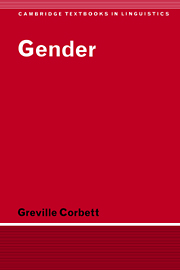Book contents
- Frontmatter
- Contents
- List of figures
- List of tables
- Preface
- List of abbreviations
- 1 INTRODUCTION
- 2 GENDER ASSIGNMENT I: SEMANTIC SYSTEMS
- 3 GENDER ASSIGNMENT II: FORMAL SYSTEMS
- 4 THE PSYCHOLINGUISTIC STATUS OF GENDER ASSIGNMENT
- 5 GENDER AGREEMENT
- 6 ESTABLISHING THE NUMBER OF GENDERS
- 7 TARGET GENDERS: SYNCRETISM AND ENFORCED GENDER FORMS
- 8 HYBRID NOUNS AND THE AGREEMENT HIERARCHY
- 9 GENDER RESOLUTION RULES
- 10 GENERALIZATIONS AND PROSPECTS
- References
- Author index
- Language index
- Subject index
6 - ESTABLISHING THE NUMBER OF GENDERS
Published online by Cambridge University Press: 05 June 2012
- Frontmatter
- Contents
- List of figures
- List of tables
- Preface
- List of abbreviations
- 1 INTRODUCTION
- 2 GENDER ASSIGNMENT I: SEMANTIC SYSTEMS
- 3 GENDER ASSIGNMENT II: FORMAL SYSTEMS
- 4 THE PSYCHOLINGUISTIC STATUS OF GENDER ASSIGNMENT
- 5 GENDER AGREEMENT
- 6 ESTABLISHING THE NUMBER OF GENDERS
- 7 TARGET GENDERS: SYNCRETISM AND ENFORCED GENDER FORMS
- 8 HYBRID NOUNS AND THE AGREEMENT HIERARCHY
- 9 GENDER RESOLUTION RULES
- 10 GENERALIZATIONS AND PROSPECTS
- References
- Author index
- Language index
- Subject index
Summary
In the first chapters of the book it was largely taken for granted that the number of genders in a given language could be readily established, and we tackled the problem of how nouns are assigned to particular genders. Then in the preceding chapter we considered the syntactic means by which gender is manifested. And we saw that in some instances the evidence is complex. We need, therefore, to work out how we determine the number of genders in a given language. In several of the more familiar languages, the gender pattern is straightforward and the way in which the system is analysed is taken as self-evident. In other languages, linguists may present the pattern as though it were equally uncontroversial, but we find that similar situations are described differently by those working on different language families. In contrast, the number of genders in a particular language can be the subject of interminable dispute. Given this unsatisfactory situation, we must develop a consistent approach to analysing gender. For those most familiar with languages which have relatively transparent gender systems, this chapter may appear unduly detailed. But in order to make meaningful comparisons between such languages and those with more complex gender systems we need to ensure that the starting point is the same. After a brief discussion of terminology (section 6.1), we move on to the central notion of ‘agreement class’ (section 6.2). In section 6.3 we investigate how the nouns in an agreement class may make up a ‘controller gender’.
- Type
- Chapter
- Information
- Gender , pp. 145 - 188Publisher: Cambridge University PressPrint publication year: 1991



